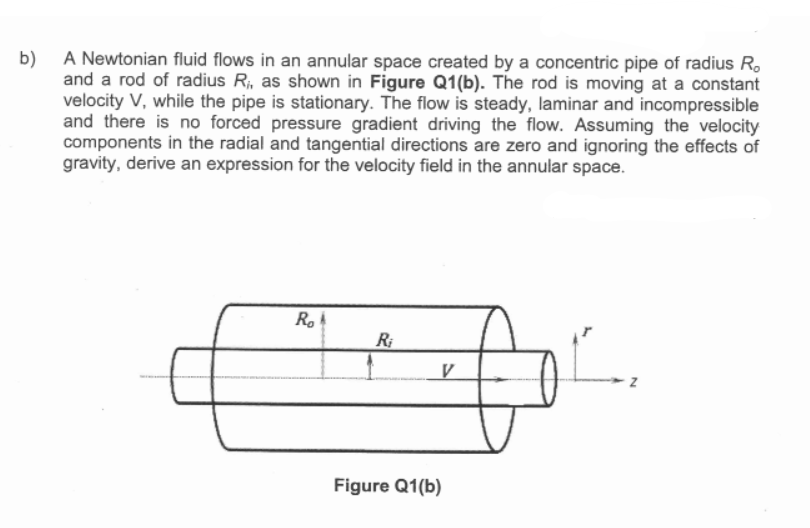A Newtonian fluid flows in an annular space created by a concentric pipe of radius R. and a rod of radius R, as shown in Figure Q1(b). The rod is moving at a constant velocity V, while the pipe is stationary. The flow is steady, laminar and incompressible and there is no forced pressure gradient driving the flow. Assuming the velocity components in the radial and tangential directions are zero and ignoring the effects of gravity, derive an expression for the velocity field in the annular space.
A Newtonian fluid flows in an annular space created by a concentric pipe of radius R. and a rod of radius R, as shown in Figure Q1(b). The rod is moving at a constant velocity V, while the pipe is stationary. The flow is steady, laminar and incompressible and there is no forced pressure gradient driving the flow. Assuming the velocity components in the radial and tangential directions are zero and ignoring the effects of gravity, derive an expression for the velocity field in the annular space.
Elements Of Electromagnetics
7th Edition
ISBN:9780190698614
Author:Sadiku, Matthew N. O.
Publisher:Sadiku, Matthew N. O.
ChapterMA: Math Assessment
Section: Chapter Questions
Problem 1.1MA
Related questions
Question

Transcribed Image Text:b)
A Newtonian fluid flows in an annular space created by a concentric pipe of radius R,
and a rod of radius R;, as shown in Figure Q1(b). The rod is moving at a constant
velocity V, while the pipe is stationary. The flow is steady, laminar and incompressible
and there is no forced pressure gradient driving the flow. Assuming the velocity
components in the radial and tangential directions are zero and ignoring the effects of
gravity, derive an expression for the velocity field in the annular space.
R.
R:
Figure Q1(b)
Expert Solution
This question has been solved!
Explore an expertly crafted, step-by-step solution for a thorough understanding of key concepts.
This is a popular solution!
Trending now
This is a popular solution!
Step by step
Solved in 2 steps with 2 images

Knowledge Booster
Learn more about
Need a deep-dive on the concept behind this application? Look no further. Learn more about this topic, mechanical-engineering and related others by exploring similar questions and additional content below.Recommended textbooks for you

Elements Of Electromagnetics
Mechanical Engineering
ISBN:
9780190698614
Author:
Sadiku, Matthew N. O.
Publisher:
Oxford University Press

Mechanics of Materials (10th Edition)
Mechanical Engineering
ISBN:
9780134319650
Author:
Russell C. Hibbeler
Publisher:
PEARSON

Thermodynamics: An Engineering Approach
Mechanical Engineering
ISBN:
9781259822674
Author:
Yunus A. Cengel Dr., Michael A. Boles
Publisher:
McGraw-Hill Education

Elements Of Electromagnetics
Mechanical Engineering
ISBN:
9780190698614
Author:
Sadiku, Matthew N. O.
Publisher:
Oxford University Press

Mechanics of Materials (10th Edition)
Mechanical Engineering
ISBN:
9780134319650
Author:
Russell C. Hibbeler
Publisher:
PEARSON

Thermodynamics: An Engineering Approach
Mechanical Engineering
ISBN:
9781259822674
Author:
Yunus A. Cengel Dr., Michael A. Boles
Publisher:
McGraw-Hill Education

Control Systems Engineering
Mechanical Engineering
ISBN:
9781118170519
Author:
Norman S. Nise
Publisher:
WILEY

Mechanics of Materials (MindTap Course List)
Mechanical Engineering
ISBN:
9781337093347
Author:
Barry J. Goodno, James M. Gere
Publisher:
Cengage Learning

Engineering Mechanics: Statics
Mechanical Engineering
ISBN:
9781118807330
Author:
James L. Meriam, L. G. Kraige, J. N. Bolton
Publisher:
WILEY